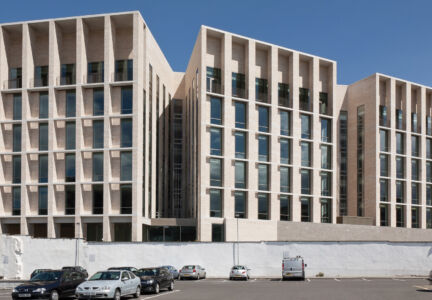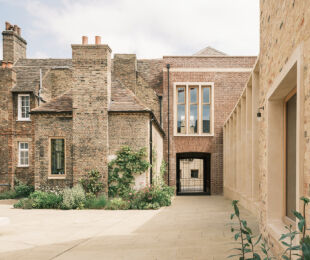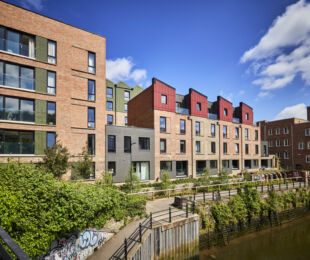REIACH & HALL ARCHITECTS: PENNY LEWIS DISCUSSES REIACH & HALL'S BRICK ARCHITECTURE WITH NEIL GILLESPIE

I met Peter Cook in the USA pavilion at last summer’s Venice Biennale bemoaning Britain’s ‘hair-shirt’ architecture and lamenting the current taste for formal and material restraint. On his return to the UK the Archigram veteran made a public declaration against the so-called ‘biscuit boys’. According to Cook, the profession seems to have divided into two camps: those that use brick and those that don’t. And those that do stand accused of a nostalgia; a yearning for a kind of architecture and procurement that is finished.
Neil Gillespie, design director of Reiach & Hall, has had two beautiful ‘biscuit coloured’ buildings in the last two shortlists for the Stirling Prize: Maggie’s Centre Lanarkshire in 2015 and Glasgow College in 2016. He has an unapologetic passion for building in brick, an attitude which he shares with many practices, such as Sergison Bates and Caruso St John.
Gillespie is polite, generous and rarely polemical, but he is angry at the suggestion that as a ‘biscuit boy’ he is living in the past. For Gillespie, it’s Cook who fails to understand the contemporary condition. Specifying brick, argues Gillespie, is now one of the ways in which British architects can retain some control over a design. “Procurement is really contractor-led and I put the emphasis on the ‘contractor’ as opposed to the ‘builder’. The contractor is organising the building but not necessarily constructing it. They prefer industrialised systems, things that can be measured, subcontractors that can be nailed to the floor and costs that can be controlled. A craft-based construction worries them,” says Gillespie. The impulse to specify brick comes from the desire to have facades that are ‘made’ as opposed to ‘assembled’ explains Gillespie. “There is still an inherent skill with brickwork, although not the same level of skill as with masonry; brick is an industrialised product that still enables you to work with it.”
Reiach & Hall’s main workload is in leisure, health and education. “It seems to me that if you get involved with a hospital or a school you are immediately faced with manipulating some industrialised products. We don’t just want to assemble other people’s designed components, because then we are not …” (he wants to say ‘architects’ but holds back). “You are not a designer, you are really just organising other people’s products, where the quality has been decided by someone else, the product designer. In the 1950s and 1960s as an architect you would take responsibility for designing the glazing system and bear the responsibilities for its failure. Maybe this sounds nostalgic, and it probably is.”
So is the use of brick subverting current procurement methods? “I think it is. With brick there is still a need for you to be involved in the making. There is still a discussion to be had between the architect and the person on site; there seems to be a desire to make a connection between drawing and making something.” Gillespie’s pragmatic arguments about the use of brick are not intended to negate the qualities of brick itself. “There is a quality about brick that has important associations: it’s fired, it’s from the earth and it’s got real presence.”
Two of the practice’s recent brick buildings, Dundee Council administrative headquarters (2011) and the National Operations Centre for Scottish Water, Glasgow (2013), share the ambition to create a civic facade. In Dundee the council offices were formed by extending an old industrial brick building faced in stone. “We were responding to the brick as if the real story of the structure was that of a brick building, and we were going to express it proudly”, explains Gillespie.
“The Scottish Water headquarters sits on the edge of an industrial estate. Brick was selected to give the scheme some sense of strength and permanence among buildings designed to disappear. We thought an institution like Scottish Water – there can be nothing more fundamental to culture than fresh water – needed to be built in a civic manner, the way the Victorians would have built an edifice.”
“When we were designing Bannockburn Battlefield Visitor Centre in Sterling (2014) we were desperately trying to find a robust material and would have clad it in stone if we had the budget. We were trying to make an enigmatic form, but rendered as if it had been burnt or battle-scarred. It could have been clad in burnt timber but it wouldn’t have been robust. Brick is civic, robust, flexible and appeals to a mood among public commissioners. There are a lot of formats, a huge range of colours, and a desire to make facades that are more interesting. We are trying to be friendly again and the public responds positively to brick”, he adds.
Gillespie’s enthusiasm for brick is not a passing fad, brick buildings are part of Reiach & Hall’s tradition. When they formed a practice in 1966, Alan Reiach and Eric Hall, like many Scots of their generation, were inspired by Arne Jacobsen and Jørn Utzon. Reiach’s pamphlet Building Scotland (Hurd and Reiach 1941) was a clarion call to Scottish Modernists, identifying new public buildings in Stockholm and elsewhere in Scandinavia as sources of inspiration.
The design for Maggie’s Centre Lanarkshire harks back to that moment, and to Danish modernism. “It’s about a simple house set in a landscape, the kind of work produced when we were founded; they feel like better times, certainly architecturally”, says Gillespie. The brickwork is beautiful, an occasional Roman-style linear brick is used to ‘spoil’ the bonding pattern. “I like the idea of ambiguity”, observes Gillespie. “The thing about this type of brick is its relaxed tolerance, which you make up with the mortar.”
Although Gillespie likes ambiguity his work is highly refined. The practice doesn’t always work in brick, and it is soon to complete a building in a peat bog in Caithness which is clad in finely ribbed aluminium – a material that catches the northern light. The Beatson Institute for Cancer Research, Glagow (2008) is an elegant glass box that sits within an old walled garden. “In many ways the glass was a response to brick; if we’d done a brick building within a brick wall it wouldn’t have worked,” explains the architect.
Gillespie is committed to working with the industry to find ways in which the architect can contribute; brick has allowed him to do that. Is there any down side to the current renaissance in brick building? “My fear is that there is a gradual erosion of our interest in making in general, and if we get a brick building we are satisfied. We need to push a material’s potential to ensure the bar is raised in the future and not lowered.”
Penny Lewis is a writer and lecturer in architecture at the Robert Gordon University in Aberdeen.






